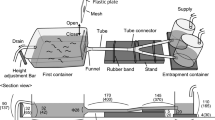Synopsis
The study investigates the sensitivity and the chemotaxis of glass eels caught during upstream migration with respect to freshwater solutions of 8 pure chemicals with earthy or green odour: 2-methyl-3-methoxypyrazine; 2-isobutyl-3-methoxypyrazine; 4-methylthiazole; 4-isopropyl-7-methylcyclohexathiazole; 1,2,2,6-tetramethylcyclohexanol; 1-ethyl-2,2,6-trimethylcyclohexanol; (L) and (D) 2-methylfenchol. All the tested substances are potent stimuli. Extremely low concentrations (ranging between 10-9 and 10-13 mg 1-1) are sufficient to elicit a choice in the fish. These chemicals, all of which are clearly attractive, could act as kairomones and play a fundamental orienting role in the upstream migration of glass eels.
Similar content being viewed by others
References cited
Atema, J., S. Jacobson, J. Todd & D. Boylan. 1973. The importance of chemical signals in stimulating behavior of marine organisms: effects of altered environmental chemistry on animal communication. pp. 177–197.In.: G.E. Glass (ed.) Bioassay Techniques and Environmental Chemistry, Mich. Sci. Publ., Ann Arbor.
Boëtius, J. 1976. Elvers,Anguilla anguilla andAnguilla rostrata from two Danish localities. Size, body weight, developmental stage and number of vertebrae related to time of ascent. Meddr. Danm. Fisk. og Havunders 7: 199–220.
Brown, W.L., T. Eisner & R.M. Whittaker. 1970. Allomones and kairomones: transspecific chemical messengers. BioScience 20: 21–22.
Buttery, D.G., R.M. Seifert, D.G. Guadagni & L.C. Ling. 1969. Characterization of some volatile constituents of bell pepper. J. Agric. Food Chem. 17: 1322–1327.
Creutzberg, F. 1961. On the orientation of migrating elvers (Anguilla vulgaris Turt.) in a tidal area. Neth. J. Sea Res. 1: 257–338.
Finato, B., R. Lorenzi & P. Pelosi. 1992. Synthesis of new earthy odorants. J. Agric. Food Chem. 40: 857–859.
Gerber, N.N. 1968. Geosmin, from microorganisms, istrans-1,10-dimethyl-trans-9-decalol. Tetrahedron Letters 25: 2971–2974.
Gerber, N.N. & H.A. Lechevalier. 1965. Geosmin, an earthysmelling substance isolated from actinomycetes. Appl. Environ. Microbiol. 13: 935–938.
Hara, T.J. 1992. Mechanisms of olfaction. pp. 150–170.In: T.J. Hara (ed.) Fish Chemoreception, Chapman & Hall, London.
Hara, T.J. 1994. The diversity of chemical stimulation in fish olfaction and gustation. Rev. Fish Biol. Fish. 4: 1–35.
Hasler, A.D. & A.T. Scholz. 1983. Olfactory imprinting and homing in salmon. Investigations into the mechanisms of the imprinting process. Springer-Verlag, Heidelberg. 134 pp.
Hasler, A.D. & W.J. Wisby. 1951. Discrimination of stream odors by fishes and its relation to parent stream behavior. Amer. Nat. 85: 223–238.
Hwang, C.J., S.W. Krasner, M.J. McGuire, M.S. Moylan & M.S. Dale. 1984. Determination of subnanogram per liter levels of earthy-musty odorants in water by the salted closed-loop stripping method. Environ. Sci. Technol. 18: 535–539.
Jüttner, F. 1984. Dynamics of the volatile organic substances associated with cyanobacteria and algae in a eutrophic shallow lake. Appl. Environ. Microbiol. 47: 814–820.
Kawamura, G., H. Nakaizumi & T. Motohiro. 1992. Chemical perception and response of the Nile tilapia to geosmin. Water Sci. Technol. 25: 277–282.
Marui, T. & J. Caprio. 1992. Teleost gustation. pp. 171–198.In: T.J. Hara (ed.) Fish Chemoreception, Chapman & Hall, London.
Medsker, L.L., D. Jenkins & S.F. Thomas. 1968. Odorous compounds in natural waters. An earthy-smelling compound associated with blue-green algae and actinomycetes. Environ. Sci. Technol. 2: 461–464.
Miles, S.G. 1968. Rheotaxis of elvers of the American eel (Anguilla rostrata) in the laboratory to water from different streams in Nova Scotia. J. Fish. Res. Board Can. 25: 1591–1602.
Murray, K.E. & F.B. Whitfield. 1975. The occurrence of 3-alkyl-2-methoxypyrazines in raw vegetables. J. Sci. Food Agric. 26: 973–986.
Northcote, T.G. 1984. Mechanisms of fish migration in rivers. pp. 317–355.In: J.D. McCleave, G.P. Arnold, J.J. Dodson & W.H. Neill (ed.) Mechanisms of Migration in Fishes, Plenum Press, New York.
Pelosi, P. 1989. Towards an objective evaluation of odours in foods. Ital. J. Food Sci. 1: 5–22.
Pelosi, P & R. Tirindelli. 1989. Structure/activity studies and characterization of an odorant-binding protein. pp. 207–226.In: J.G. Brandt, J.H. Teeter, R.H. Cagan & M.R. Kare (ed.) Chemical Senses, Vol 1, Receptors Event and Transduction in Taste and Olfaction, M. Dekker, New York.
Pelosi, P, P. Pasqualetto & R. Lorenzi. 1983. Synthesis and olfactory properties of some thiazoles with bell pepper like odor. J. Agric. Food Chem. 31: 482–484.
Persson, P.E. & F. Jüttner. 1983. Threshold odour concentrations of odorous algal metabolites occurring in lake water. Aqua Fennica 13: 3–7.
Persson, P.E., F.B. Whitfield & S.W. Krasner. 1992. Off-flavour in drinking water and aquatic organisms. Wat. Sci. Tech. 25, Pergamon Press, Oxford. 343 pp.
Smith, R.J.F. 1985. The control of fish migration. Springer-Verlag, Berlin. 243 pp.
Sola, C. & L. Tosi. 1993. Bile salts and taurine as chemical stimuli for glass eels,Anguilla anguilla: a behavioural study. Env. Biol. Fish. 37: 197–204.
Sola. C., P.G. Giulianini & E.A. Ferrero. 1993a. Ultrastructural characterization of the olfactory organ in glass eels,Anguilla anguilla (Osteichthyes, Anguilliformes). Boll. Zool. 60: 253–261.
Sola, C., A. Spampanato & L. Tosi. 1993b. Behavioural responses of glass-eels (Anguilla anguilla L.) towards amino acids. J. Fish Biol. 42: 683–691.
Sorensen, P.W. 1986. Origins of the freshwater attractant(s) of migrating elvers of the American eelAnguilla rostrata. Env. Biol. Fish. 17: 185–200.
Sorensen, P.W. 1992. Hormones, pheromones and chemoreception. pp. 199–228.In: T.J. Hara (ed.) Fish Chemoreception, Chapman & Hall, London.
Stabell, O.B. 1992. Olfactory control of homing behaviour in salmonids. pp. 249–270.In: T.J. Hara (ed.) Fish Chemoreception, Chapman & Hall, London.
Thunberg, B.E. 1971. Olfaction in parent stream selection by the alewife (Alosa pseudoharengus). Anim. Behav. 19: 217–225.
Tosi, L. & C. Sola. 1993. Role of geosmin, a typical inland water odour, in guiding glass eelsAnguilla anguilla (L.) migration. Ethology 95: 177–185.
Tosi. L., A. Spampanato, C. Sola & P. Tongiorgi. 1990. Relation of water odour, salinity and temperature to ascent of glasseels,Anguilla anguilla (L.): a laboratory study. J. Fish Biol. 36: 327–340.
Author information
Authors and Affiliations
Rights and permissions
About this article
Cite this article
Sola, C. Chemoattraction of upstream migrating glass eelsAnguilla anguilla to earthy and green odorants. Environ Biol Fish 43, 179–185 (1995). https://doi.org/10.1007/BF00002489
Received:
Accepted:
Issue Date:
DOI: https://doi.org/10.1007/BF00002489




